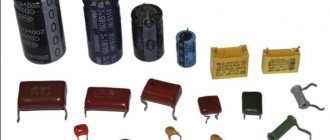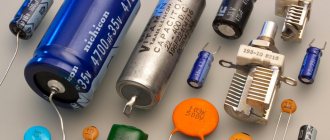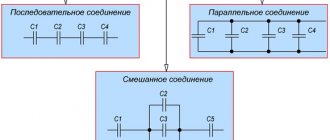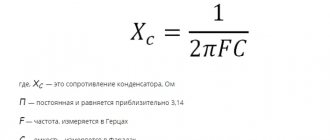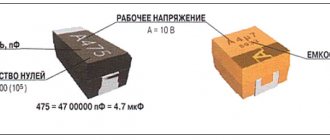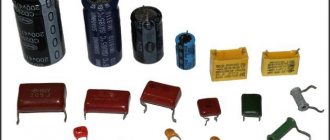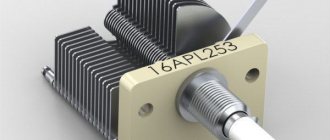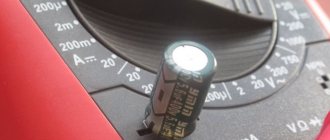High-voltage (HV) capacitors are devices widely used in electrical circuits of various devices and equipment under very high voltage. Unlike low-voltage analogues, they have a reliable design, a long service life, and high cost. What such devices are, what types they are, how they work and where they are used will be discussed in this article.
High voltage capacitor
Types of high-voltage capacitors
Depending on the design features and dielectric material, these devices can be ceramic, paper, metallized, oil-based, vacuum, phase-shifting, trimming, bipolar.
Ceramic products
Ceramic pulse capacitors are storage devices in which special ceramics are used as a dielectric. Unlike low-voltage analogues, such conductors operate at voltages from 0.2 to 50 kV and current frequencies from 0.5 to 10 kHz. Moreover, their capacity lies in the range from 2-2.5 to 25 nf. They are used in DC, AC or pulsating current circuits, network filters such as X/Y capacitors, as well as high-frequency circuits to eliminate interference and absorb noise.
The most commonly used brands of these devices are the following:
- K75-25 (15);
- K15-4;
- K15-5;
- K15-10;
- KVI-3.
Ceramic charge storage KVI-3
Metallized and paper (film)
Charge storage devices of these types having a similar design consist of:
- Dielectric - capacitor paper, polymer film made from materials such as polypropylene, polyester, polycarbonate.
- Plating - foil or a thin layer of metal deposited on a film polymer dielectric by vacuum deposition.
- Two contacts (leads) soldered to the plates.
The most popular among film-metalized devices are models with operating voltages of 16 and 25 kV and a capacity of 2200 pF (2.2 nF).
Storage devices with a paper dielectric, in contrast to metallized film analogues, have a lower operating (rated) voltage: from 0.2 to 15 kV (200-1500 V). However, their capacitance ranges from 0.1 to 2 μF (100,000 - 2,000,000 pF or 100-2000 nF). Like analogues with a ceramic dielectric, they are capable of working with currents with a frequency from 50 to 10,000 Hz (10 kHz).
Film and paper high-voltage capacitors are used in rectifier and filter circuits, electronic multipliers and voltage doublers.
On a note. In paper charge storage devices, deviation of the storage capacity from the nominal value of this characteristic is allowed by no more than 20%.
Capacitor mbgch-1
Oil and vacuum samples
The most commonly used and in demand vacuum high-frequency variable capacitor brand KP 1-4 is a device consisting of the following parts:
- a glass container, inside of which a high vacuum is created by pumping out air;
- fixed cylindrical electrode;
- corrugated movable electrode (“accordion”);
- the drive of the movable electrode, which, under great force, moves the “accordion” inside the stationary electrode;
- round handle and window with a scale for adjusting the storage capacity.
The capacity of this drive ranges from 10 to 500 pF, operating voltage – up to 10 kV. Such a device is used in amateur radio transmitting equipment in the frequency range up to 30-80 MHz as loop, blocking, filter, and separating capacitors.
The oil charge accumulator of the most common brand KBG-MN consists of:
- metal rectangular case;
- polymer or paper dielectric rolled into a roll;
- aluminum foil plates separated by a dielectric;
- two leads soldered to the plates and connected to contacts on the housing cover.
A twisted roll of dielectric and plates is placed in a special oil that fills the housing. The capacity of the device of this brand is 0.5 μF (500 nF), operating voltage is 600 V (0.6 kV).
On a note. High-voltage charge storage devices contain a fairly high content of various precious metals: palladium, platinum, technical silver.
Low Voltage Capacitors for Power Electronics
Low-voltage (relatively, of course, “only” 230...1000 V) applications of capacitors include, first of all, compensation of voltage drops and filtering of harmonics in systems using power frequency currents (50...60 Hz). Designed to work with voltages in the range of 230...1000 V with energy levels of the order of 2.5...56.2 kVar for aluminum housings and up to 500 kVar in a steel housing. They are produced in series for indoor use - PhMKD and for outdoor conditions - PhMKDg (Fig. 3).
Rice. 3. Low voltage capacitors for power electronics
The advantages include low loss coefficient, compact size, good dissipation of excess heat, long MTBF (over 150,000 hours), compliance with EN 60831/1 and 2, EIC 60831/1 and 2 standards.
Phase shifting
SDM capacitors without markings
These devices are used to connect a three-phase electric motor to a single-phase household network. An ordinary non-polar (electrolytic) capacitor is suitable for this.
Calculation of the required capacity of the starting phase-shifting capacitor ( C ph ) depends on the circuit (type) of connecting the motor to the network:
- When connected in a "triangle" type, the capacity of the phase-shifting storage device is calculated using the following formula: Cph = 4800 × I/U.
- For a star-connected capacitor, the capacity of the phase-shifting capacitor is determined by the following formula: Cph = 2800×I/U.
Phase shifting capacitor connected to a three-phase motor
Trimmers
These charge accumulators are devices whose capacity changes with one-time or periodic adjustments. During operation of the equipment, changing the capacity of such devices is structurally impossible.
The design of such devices includes the following elements:
- stator – fixed lower plate;
- rotor – upper movable semicircular lining;
- axis – a small pin connecting the stator and rotor.
The container is adjusted by changing the area of parallel plates using a flat slot on the axis. Trimmer high-voltage capacitors are used in transmitting and receiving radio equipment.
On a note. A tuning capacitor should not be confused with a variable capacitor - the capacitance of the latter can be changed during operation of the equipment.
Bipolar
A device of this type is a simple non-polar (unipolar) capacitor used in electrical circuits powered by both direct and alternating or pulsating ultra-high current.
Bipolar high voltage capacitor
High Voltage Capacitors for Power Electronics
Main purpose:
- Shunt capacitors;
- Harmonic filtering;
- Series capacitors;
- Capacitors for static reactive power compensation;
- Capacitors for high-voltage DC power lines;
- Voltage limiters and filters.
Vishay high voltage capacitors are available up to voltage levels of 24 kV and power levels up to 900 kVar. Banks of capacitors are also offered that allow operating voltages up to 800 kV.
Available in versions with one and two contact sleeves, single- and three-phase capacitors are offered (Fig. 4).
Rice. 4. High voltage capacitors for power electronics
Design solutions make it possible to combine individual capacitors into banks and capacitor fields with protection against phase imbalance.
Principle of operation
Any high-voltage energy-intensive charge storage device has the same operating principle as its low-voltage counterpart, consisting of two main stages:
- Charging - when the plates are connected to a power source or electrical network, a charge begins to accumulate on them. In this case, the voltage across the capacitor increases and after a short time becomes the same as that of the power source. From this moment the drive is considered charged
- Discharge – if you connect a load to a charged storage device, an electric current will begin to flow through it. In this case, the voltage on the plates will quickly drop until it dries out completely.
What is a capacitor used for?
If the current supplied to the capacitor is not rated correctly, dielectric breakdown may occur, resulting in a short circuit and short-circuiting the device.
Important! The expression “short-circuited” in the language of electricians means that a short circuit has occurred.
Capacitors for high voltage power supplies
High voltage power supplies are used in medical imaging systems, CRT monitors, electrostatic coating (automotive), and electrostatic precipitators (industrial).
Vishay high-voltage capacitors comply with the standards EN 50176, EN 50177, EN 50223, EN 50348. DC operating voltage ranges 1...100 kV (Fig. 5).
Rice. 5. Capacitors for high voltage power supplies
Capacitors are a compact, flexible, reliable solution for high-voltage power supplies for a wide range of applications and industries. Available as high-voltage systems of the BG 1971-000-9000A, BG 1971-000-9700 and BG 1972-6100-010, BG 1972-6123-01 series.
BG 1971-000-9000A, BG 1971-000-9700 - compact devices with an integrated control board for liquid paint or powder coating systems. Supply voltage 30 V at current consumption 1.5...5 A, output voltage up to 100 kV, current 250...500 µA.
BG 1972-6100-010, BG 1972-6123-01 - compact high-voltage generators in a cylindrical housing with a supply voltage of 1...24 V and an output voltage of up to 100 kV.
Where are they used?
High-voltage charge storage devices are used in circuits of such high-energy-intensive devices as:
- voltage multipliers,
- Marx generators,
- Tesla coils,
- high-frequency pulse units,
- amateur radio and professional transmitting and receiving equipment,
- starting blocks of three-phase electric motors of high and medium power.
Tesla Coil
High-voltage charge storage devices, in contrast to analogues used at lower voltage values, are very dangerous devices for the human body. Thus, a charged drive in contact with careless handling can lead to serious electrical injury, damage to the skin and internal organs. Powerful devices of this type can accumulate a charge, the passage of which through the human body is extremely dangerous.
Pulse Conversion Basics
The operation of such devices, also called switching stabilizers (IS), is based on key stabilization. The circuit contains an element that adjusts the output parameters due to its locking and unlocking.
A conventional transformer circuit includes a low-frequency transformer with a primary and secondary winding. Pulse conversion also implies the presence of a transformer, but a high-frequency one.
Attention! High-frequency pulse transformers are smaller in size and cheaper, but their power is higher. Pulse voltage converters (PVC) allow the use of three types of circuits:
Pulse voltage converters (PVC) allow the use of three types of circuits:
- increasing;
- downward;
- inverter
IPNs have high efficiency and small dimensions. They include the following elements:
- power supply (power supply);
- key – switching element;
- energy storage device of inductive nature – inductor, coil;
- blocking diode;
- output voltage filter – high-capacity capacitor.
The filter is usually connected in parallel with the load.
Capacitors for power frequency installations
This type includes devices for increasing the power factor in alternating current installations with a certain, constant frequency of 50 Hz. Such devices are designed for both indoor and outdoor use at temperatures not exceeding 50 °C. They are available in both single-phase and three-phase versions. In a three-phase design, the power cosine capacitor is connected in the form of a triangle. Sometimes a fuse is used to protect against breakdown.
Automatic interruption of power supply to capacitors when the power network is overloaded with current due to increased voltage is provided by a special electric current relay. Protection against short circuit currents is achieved by installing fuses. In control circuits, large magnetic starters are used for switching on and off; the units are equipped with adjustment capabilities and operating status indicators.
Filter and pulse capacitors
Filter devices are designed to operate in high-frequency filter circuits of specialized traction substations both indoors and outdoors. They operate with the simultaneous application of direct and alternating current voltages with a frequency of 100 to 1600 Hz, while the value of the alternating current voltage should not exceed 1 kV, respectively. This type is also used for operation in DC-DC converters containing pulsed thyristors.
Filter capacitors are used to smooth out surges in the alternating component in high-voltage rectification devices in the network, as well as in double-voltage circuits in dielectric transformer oil and in high-frequency filter circuits of traction substations.
In electrical installations used for high-voltage pulsed substations, as well as installations used for magnetic stamping, seismic exploration and rock crushing, pulsed power capacitors are used. They are used in electrophysical installations to create and study high-temperature plasma, as well as for ultra-strong pulsed currents. To create powerful pulsed light sources, as well as for research using laser systems, pulsed power capacitors are used.
The peculiarity of the operation of these devices is that the charging moment is slowly flowing, and, conversely, the discharge occurs quickly, pulsed. In addition to such capacitors, pulsed network voltage generators are also used.
The network pulse voltage generator is used mainly for electro-hydraulic installations that use electric discharge for technological purposes, due to special production conditions or technological process. Such generators are available for mains voltages of 380, 400, 415, 440 V. The rated output voltage is 50 kV, the total output power is 18 kW, and the reactive power factor is 0.73.
Pulse voltage generators are made of two blocks: charging and high-voltage compartments. The charging unit includes a step-down transformer and a cabinet with a converter containing a capacitive-inductive component. The high-voltage compartment is represented by a cabinet with power capacitors, a protective device and a spark gap, and there is also a separation grounding.
Capacitors in gadgets
Now comes a truly detailed debriefing. In gadgets, capacitors have much more power than in a guitar. But if you think that bad capacitors will make the sound dry and muddy, then you are very much mistaken.
All capacitors, provided that they have the same capacitance, have an almost identical effect on the sound. Actually, it would seem, why bother then? We put capacitors of the required ratings everywhere and it will work) In fact, it will most likely work, but it’s not a fact that it’s the way you need it.
Yes, by and large, it’s not even a fact that it will happen. Actually, we will figure out how not to screw things up using different capacitors. If you want to keep it short, there is a universal recipe - film and aluminum. Just don't forget about polarity. And you will be happy)
Now, let's take a look at the different types of capacitors. Let's see how they differ from each other and where which ones are best used. Let me remind you once again that I am considering the use of capacitors within the framework of guitar gadgets.
